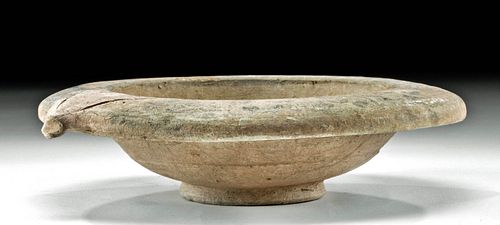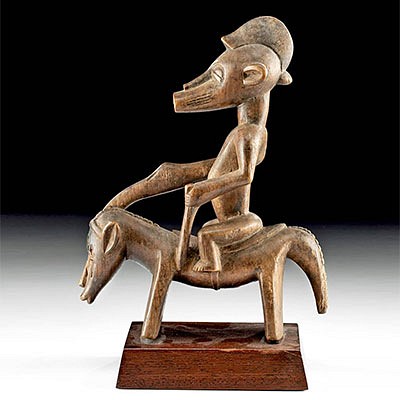Roman Polychrome Mortarium
Lot 18
About Seller
Artemis Fine Arts
686 S Taylor Ave, Ste 106
Louisville, CO 80027
United States
Selling antiquities, ancient and ethnographic art online since 1993, Artemis Gallery specializes in Classical Antiquities (Egyptian, Greek, Roman, Near Eastern), Asian, Pre-Columbian, African / Tribal / Oceanographic art. Our extensive inventory includes pottery, stone, metal, wood, glass and textil...Read more
Categories
Estimate:
$600 - $900
Absentee vs Live bid
Two ways to bid:
- Leave a max absentee bid and the platform will bid on your behalf up to your maximum bid during the live auction.
- Bid live during the auction and your bids will be submitted real-time to the auctioneer.
Bid Increments
| Price | Bid Increment |
|---|---|
| $0 | $25 |
| $300 | $50 |
| $1,000 | $100 |
| $2,000 | $250 |
| $5,000 | $500 |
| $10,000 | $1,000 |
| $20,000 | $2,500 |
| $50,000 | $5,000 |
| $100,000 | $10,000 |
| $200,000 | $20,000 |
About Auction
By Artemis Fine Arts
Feb 17, 2022
Set Reminder
2022-02-17 10:00:00
2022-02-17 10:00:00
America/New_York
Bidsquare
Bidsquare : CLEARANCE | Ancient & Ethnographic Art
https://www.bidsquare.com/auctions/artemis-gallery/clearance-ancient-ethnographic-art-8898
Join us for our first clearance sale of the year featuring discounted pricing and many new items! Asian art, Classical antiquities from Egypt, Greece, Italy, and the Near East...plus Pre-Columbian, Tribal, Spanish Colonial, Fine Art, Fossils, more! Artemis Fine Arts info@artemisgallery.com
Join us for our first clearance sale of the year featuring discounted pricing and many new items! Asian art, Classical antiquities from Egypt, Greece, Italy, and the Near East...plus Pre-Columbian, Tribal, Spanish Colonial, Fine Art, Fossils, more! Artemis Fine Arts info@artemisgallery.com
- Lot Description
**First Time At Auction**
Rome, Imperial Period, ca. 1st to 4th century CE. A beautiful pottery mortarium presenting a wide rim that dramatically flares outwards above a shallow basin, all sitting upon a ring-form foot. A creamy beige slip envelops the interior basin, while the top of the rim is adorned by a lovely polka dot motif in black, white, pink, and green pigments. Alternatively, the exterior of the bowl is embellished by several incised rings. A pointed spout projects from one side of the rim, outlined by incised striations. The opposite side of the rim displays a pair of petite drill holes for suspension. Mortaria were heavy bowls, often with thick flanges, with sand and grit embedded in their internal surfaces. These were used for pounding and mixing foods. Size: 8.8" in diameter x 2" H (22.4 cm x 5.1 cm)
Mortaria are frequently found in the furthest outposts of the Roman Empire, a sign of the standardized spread of Roman cooking methods. Mortaria were hugely important at forts and their remains are often found in great quantities there - both imported and produced in local marketplaces.
Provenance: private Toluca Lake, California, USA collection, before 2000
All items legal to buy/sell under U.S. Statute covering cultural patrimony Code 2600, CHAPTER 14, and are guaranteed to be as described or your money back.
A Certificate of Authenticity will accompany all winning bids.
PLEASE NOTE: Due to recent increases of shipments being seized by Australian & German customs (even for items with pre-UNESCO provenance), we will no longer ship most antiquities and ancient Chinese art to Australia & Germany. For categories of items that are acceptable to ship to Australia or Germany, please contact us directly or work with your local customs brokerage firm.
Display stands not described as included/custom in the item description are for photography purposes only and will not be included with the item upon shipping.
#164406Collection label on base. Chip to spout. Expected surface wear, commensurate with age. Otherwise, very nice with liberal remains of pigments.Condition
- Shipping Info
-
All shipping is handled in-house for your convenience. Your invoice from Artemis Gallery will include shipping calculation instructions. If in doubt, please inquire BEFORE bidding for estimated shipping costs for individual items.
-
- Buyer's Premium



 EUR
EUR CAD
CAD AUD
AUD GBP
GBP MXN
MXN HKD
HKD CNY
CNY MYR
MYR SEK
SEK SGD
SGD CHF
CHF THB
THB















